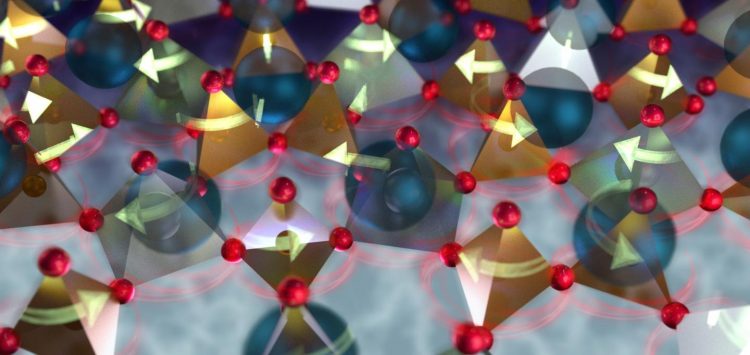Supersonic waves may help electronics beat the heat

Neutron scattering studies of lattice excitations in a fresnoite crystal revealed a way to speed thermal conduction. Credit: Oak Ridge National Laboratory, US Dept. of Energy; graphic artist Jill Hemman
“The discovery gives you a different way to control the flow of heat,” said lead author Michael Manley of the paper published in Nature Communications. “It provides a shortcut through the material–a way to send the energy of pure atomic motion at a speed that's higher than you can with phonons [atomic vibrations].
This shortcut may open possibilities in heat management of nanoscale materials. Imagine the possibility of a thermal circuit breaker, for example.”
The scientists used neutron scattering to measure phasons with velocities about 2.8 times and about 4.3 times faster than the natural “speed limits” of longitudinal and transverse acoustic waves, respectively. “We didn't expect them to be going that fast without [fading],” Manley said.
Insulators are necessary in electronic devices to prevent short circuits; but without free electrons, thermal transport is limited to the energy of atomic motion. Hence, understanding the transport of heat by atomic motion in insulators is important.
The researchers scattered neutrons in fresnoite, a crystalline mineral so named because it was first found in Fresno, California. It is promising for sensor applications through its piezoelectric property, which allows it to turn mechanical stress into electrical fields.
Fresnoite has a flexible framework structure that develops a competing order in the structure that does not match the underlying crystal order, like an overlay of mismatched tiles. Phasons are excitations associated with atomic rearrangements in the crystal that change the phase of waves describing the mismatch in the structure.
Phase differences accumulate in a lattice of wrinkles–called solitons. Solitons are solitary waves that propagate with little loss of energy and retain their shape. They can also warp the local environment in a way that allows them to travel faster than sound.
“The soliton is a very deformed region in the crystal where the displacements of the atoms are large and the force-displacement relationship is no longer linear,” Manley said. “The material stiffness is locally enhanced within the soliton, leading to a faster energy transfer.”
Raffi Sahul of Meggitt Sensing Systems of Irvine, California, grew a single crystal of fresnoite and sent it to ORNL for neutron scattering experiments that Manley conceived to characterize how energy moved through the crystal. “Neutrons are the best way to study this because their wavelengths and energies are in a sense matched to the atomic vibrations,” Manley said.
Manley performed measurements with Paul Stonaha, Doug Abernathy and John Budai using time-of-?ight neutron scattering at the Spallation Neutron Source, and with Stonaha, Songxue Chi, and Raphael Hermann using triple-axis neutron scattering at the High Flux Isotope Reactor.
At SNS, the scientists started with a pulsed source of neutrons of different energies and used the ARCS instrument, which selects neutrons in a narrow energy range and scatters them off a sample so detectors can map the energy and momentum transfer over a wide range.
“The large measurement area was important to this study because the features weren't where you would normally expect them to be,” said Abernathy. “This gives the neutron measurements a great chance to determine the velocities of the propagating phasons, calculated from the slope of their dispersion curves.”
Dispersion is the relationship between the wavelength and the energy that characterizes a propagating wave.
“Once the SNS measurements told us where to look, we used triple-axis spectrometry at HFIR, which provided a constant flux of neutrons, to focus on that one point,” Manley said. “A unique thing about Oak Ridge National Laboratory is that we have both a world-class spallation source and a world-class reactor source for neutron research. We can go back and forth between facilities and really get a comprehensive view of things.”
Next the researchers will explore other crystals that, like fresnoite, can rotate phasons. Strain applied with an electric field may be able to change the rotation. Changes in temperature may vary properties too.
The title of the paper is “Supersonic propagation of lattice energy by phasons in fresnoite.”
###
The research used resources at SNS and HFIR, DOE Office of Science User Facilities at ORNL. Funding came from the DOE Office of Science.
UT-Battelle manages ORNL for DOE's Office of Science. The single largest supporter of basic research in the physical sciences in the United States, the Office of Science is working to address some of the most pressing challenges of our time. For more information, please visit https:/
Media Contact
All latest news from the category: Power and Electrical Engineering
This topic covers issues related to energy generation, conversion, transportation and consumption and how the industry is addressing the challenge of energy efficiency in general.
innovations-report provides in-depth and informative reports and articles on subjects ranging from wind energy, fuel cell technology, solar energy, geothermal energy, petroleum, gas, nuclear engineering, alternative energy and energy efficiency to fusion, hydrogen and superconductor technologies.
Newest articles

Long-sought structure of powerful anticancer natural product
…solved by integrated approach. A collaborative effort by the research groups of Professor Haruhiko Fuwa from Chuo University and Professor Masashi Tsuda from Kochi University has culminated in the structure…

Making a difference: Efficient water harvesting from air possible
Copolymer solution uses water-loving differential to induce desorption at lower temperatures. Harvesting water from the air and decreasing humidity are crucial to realizing a more comfortable life for humanity. Water-adsorption…

In major materials breakthrough
UVA team solves a nearly 200-year-old challenge in polymers. UVA researchers defy materials science rules with molecules that release stored length to decouple stiffness and stretchability. Researchers at the University…



